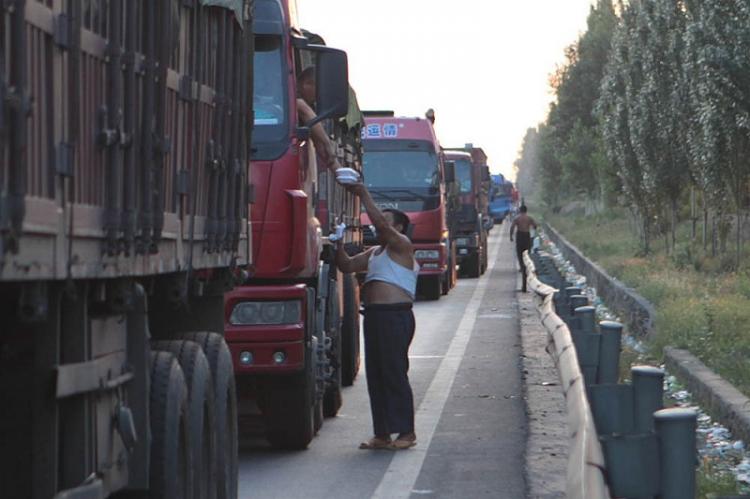An unusually large and disruptive traffic jam entered its ninth day in China on Aug. 23, and is now more than 100 km (62 miles) long.
Thousands of trucks and cars are moving in slow motion on National Expressway 110 (G110), which leads from Hebei and the Inner Mongolia region into Beijing.
Traffic began using that highway after construction began on a section of the Beijing-Tibet Expressway, which runs parallel to G110, according to CNN.
The Beijing-Tibet highway is main channel for the transportation of coal in Inner Mongolia and Shanxi to industrial areas in China. The capacity of the G110 Beijing is 25,000 cars per day, but it is now carrying 13,000 to 14,000 freight trucks, equivalent to 48,000 cars, Chinese media reports say.
Most trucks are carrying coal, a staple of industry in Inner Mongolia. While other vehicles chose to bypass the jam by taking other routes, most coal truck drivers preferred to stay on the highway to avoid fines imposed by the Coal Inspection Stations on other roads.
The overuse of the G110 by coal trucks has also led to its deterioration. Some parts of the highway are pocked with potholes of different sizes. In one section the road had two deep furrows of over 6 inches, according to reports.
Drivers, mostly owners of the large trucks, have been playing cards to pass the time, while others complain about roadside vendors and their inflated prices.
Nonetheless, many prefer to sit and wait rather than take detours. CBC reported one driver telling a state-run newspaper: “We are advised to take detours, but I would rather stay here since I will travel more distance and increase my costs.”
Recently the situation improved slightly, taking one day rather than three for trucks to pass Guxin, the most congested section in Inner Mongolia and Yanghe.
The last major traffic jam on the G110 was in June and lasted over 15 days. At the time it was joked that 80 percent of the freight-carrying trucks in northern China were trapped.
Thousands of trucks and cars are moving in slow motion on National Expressway 110 (G110), which leads from Hebei and the Inner Mongolia region into Beijing.
Traffic began using that highway after construction began on a section of the Beijing-Tibet Expressway, which runs parallel to G110, according to CNN.
The Beijing-Tibet highway is main channel for the transportation of coal in Inner Mongolia and Shanxi to industrial areas in China. The capacity of the G110 Beijing is 25,000 cars per day, but it is now carrying 13,000 to 14,000 freight trucks, equivalent to 48,000 cars, Chinese media reports say.
Most trucks are carrying coal, a staple of industry in Inner Mongolia. While other vehicles chose to bypass the jam by taking other routes, most coal truck drivers preferred to stay on the highway to avoid fines imposed by the Coal Inspection Stations on other roads.
The overuse of the G110 by coal trucks has also led to its deterioration. Some parts of the highway are pocked with potholes of different sizes. In one section the road had two deep furrows of over 6 inches, according to reports.
Drivers, mostly owners of the large trucks, have been playing cards to pass the time, while others complain about roadside vendors and their inflated prices.
Nonetheless, many prefer to sit and wait rather than take detours. CBC reported one driver telling a state-run newspaper: “We are advised to take detours, but I would rather stay here since I will travel more distance and increase my costs.”
Recently the situation improved slightly, taking one day rather than three for trucks to pass Guxin, the most congested section in Inner Mongolia and Yanghe.
The last major traffic jam on the G110 was in June and lasted over 15 days. At the time it was joked that 80 percent of the freight-carrying trucks in northern China were trapped.




